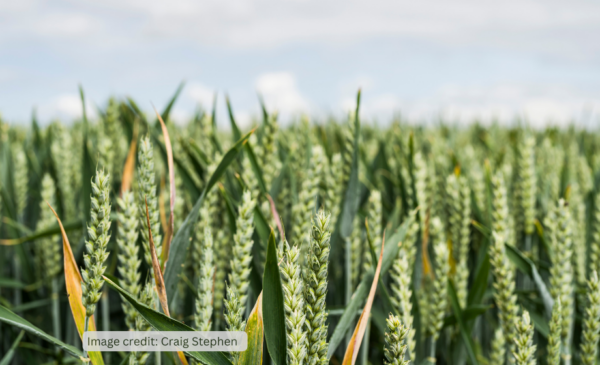Pesticides must only be used when there is a justified reason for their use. Regular checks to crops must be made to ensure that pesticides are required. If it is deemed necessary to use pesticides ensure that you follow guidance in the safe handling and mixing of pesticides section.
When applying pesticides, you must comply with General Binding Rule 23. You must ensure that you have consulted the label and maintain the buffer requirement as stated on the label. In addition, you must ensure that any pesticide application is not allowed to drift over, or be applied to the buffer along watercourses (including rivers, burns, ditchers, wetlands and lochs) as per the distance requirement stipulated in the pesticide label.
When applying to land you must ensure that you do not spray, or allow drift onto/over ground which is:
- frozen, snow covered or waterlogged (unless controlling fungal disease and in which case all precautions are taken to minimise the risk of pesticide entering the water environment).
- within 1 metre of the water environment.
- sloping unless there is a sufficient buffer to prevent pesticide run-off entering the water environment.
- within 50 metres of any spring that supplies water for human consumption, or any well or borehole (unless the well or borehole is capped to prevent the ingress of pesticide).
- impermeable draining to a surface water drainage system, or along roads, railway lines, permeable surfaces or other infrastructure unless measures are taken to minimise the risk of pesticides entering the water environment.
At all times you must ensure that the application of pesticides is carried out to minimise the risk of pollution to the water environment including not applying during rain or during conditions where drift could occur.
Once conditions are acceptable for the application of pesticides you must carry out a Control of Substances Hazardous to Health (COSHH) assessment to ensure that you comply the Health and Safety at Work Regulations.
All labels must be consulted and abided to ensure that the chemicals are used legally, appropriately and safely.
With regard to the equipment which will be used ensure:
- the applicator is serviced and calibrated;
- the correct nozzles are attached;
- the correct forward speed and boom height for spraying; and
- the correct water volume and application dose of pesticide.
Aerial Spraying
Aerial spraying is permitted in specific situations, however, there needs to be no other viable alternative. You need to contact the Health and Safety Executive (HSE) for further information and the application process can be found here.
Cross-compliance rules – On farmland it is important to note that the requirements of cross compliance prohibit the application of pesticides within 2 metres of the top of the bank of surface waters unless spot treating injurious weeds or invasive species.
Non-native species are plants and animals, which have been introduced outside of their native range by human activity. Many of these species can cause detrimental impact to the environment and it is necessary to put in control measures to reduce and remove these species. It is the responsibility of a landowner, or land manager, to prevent any non-native species on their land from spreading into the wild. If you have invasive non-native species present on your land, which you would like to remove SEPA have produced Water Use Supporting Guidance: Control of Plans in or Near to Water, which details the steps that you need to follow. This guide provides information on procedures and who you need to contact.
Pesticide may be applied within 1 metre of the water environment where the pesticide is being used to control invasive non-native species (e.g. Giant Hogweed); and
- the pesticide product used is approved for aquatic use and no pesticide enters the water
- the correct equipment is used to minimise damage to non-target species.
- the rules regarding application of pesticide (above) regarding weather conditions, slope and distances from water supplies are followed.
- care is taken to ensure that the application does not result in excessive erosion to the banks of the water environment.
- no application is made within 250 metres of an abstraction from the water environment used for providing water for human consumption.
- Contact SEPA prior to applying pesticide near water to control plants which are not classed as invasive non-native species or where pesticide is to be applied to plants in water.
It is important to ensure that you keep an up to date and accurate record of your pesticide use and applications on farm. These records help:
- Ensure that you have met your legal obligations.
- Provide proof that you have stored and used pesticides correctly.
- Improve stock management as you can see what pesticides you have, their dates and when you need to use them by.
- Provide traceability for assurance and compliance.
- Provide easier reference list to ensure that all pesticides on your premises can be legally used on farm.
- Help manage application intervals and exclusion periods.
- Improve pesticide management and use.
The Farm Advisory Service has produced guidance on all records which must be kept, see abbreviated list below. Full details and requirements can be found here.
Table 1: Guidance on pesticide records which must be adhered.
| Required by law | Good practice |
| Spray application records for every field for a period of three years. | An inventory of the pesticides in the store. |
| Control of Substances Hazardous to Health (COSHH) (When applicable). | Copies of the Material Safety Data Sheet (MSDS) for all pesticides used. |
| Disposal Records. | Copies of Extension of Authorisation for Minor Use (EAMU). |
| Environmental Risk Assessments. | |
| Personal Protective Equipment testing records. | |
| Records showing the monitoring of exposure to individuals | |
| Health surveillance |
Pesticides when spread to land must follow the guidelines from the pesticide label to ensure that an aquatic buffer be maintained to reduce the potential for diffuse pollution. In Scotland, as per GBR 23, pesticides must not be applied, or allowed to drift, to land within 1 m of any watercourse (excepting those mentioned within non-native species section). However, there are circumstances where there may be need to reduce the buffer strip as laid out within the pesticide label. In these cases, you have a legal responsibility to carry out and record a local environmental risk assessment for pesticides (LERAP). The Farm Advisory Service have produce a webpage dedicated to instruct how to conduct a LERAP.
Please note that some chemicals do not allow a reduction so consult the labels first. The Health and Safety Executive has produced further information on how to conduct a LERAP.
Pesticides are chemicals that can result in environmental pollution and can be harmful to biodiversity that inhabit farmland and water environments, if not used appropriately and as instructed. Regulations and rules regarding pesticide use are to ensure the safety of those using the chemicals but additionally to protect and reduce the impact on the wider environment.
On farm you must ensure that you follow the label guidance for each pesticide regarding buffer strips required for application of that chemical and comply with GBR 23 to prevent environmental pollution. The buffer areas are to ensure that application and potential drift is prevented on sensitive habitats such as field margins, hedges, water environment and trees. It is the responsibility of those applying the pesticides to ensure that these buffer areas are adhered to. If you do not you are liable for substantial cross compliance penalties and may cause significant environmental harm. The Farm Advisory Service has produced a guidance page on Buffer Zones to explain what is required and the regulations which must be followed, including explaining the following regulations:
- Local Environmental Risk Assessment for Pesticides (LERAP)
- Interim Scheme
- Drift Reducing Technology (DRT)
- Non-Target Anthropod Buffer Zones
The application of pesticides needs to be carried out during appropriate weather conditions to reduce the likelihood of negative environmental impact. Carrying out spreading during windy conditions results in greater risk of drift.
To limit the likelihood of drift, ensure that:
- careful application is conducted by trained personnel,
- appropriate machinery/tools used for the chemical being applied,
- application is applied during suitable weather conditions (ideal cool, humid conditions with wind speed between 2-5mph- see Table 1 for more details),
- ensure all pesticide labels are read and followed. Labels will provide information on buffer widths and equipment required,
- ensure that wind direction is known and mitigated with regard to potential drift onto sensitive habitats/population,
- topography is considered before application, for example buildings or trees resulting in change of wind pattern.
Table 2: Wind speed indictors and suitable for spraying.
| Wind speed (mph) | Under 1.2 mph | 1.2-2 mph | 2-4 mph | 4-6 mph | 6-9 mph |
| Beaufort Scale | Force 0 | Force 1 | Force 2 | Force 3 | Force 4 |
| Description | Calm | Light air | Light breeze | Gentle breeze | Moderate breeze |
| Signs | Smoke rises vertically | Smoke Drifts and showing direction of wind | Leaves rustle with wind felt in face. | Leaves and twigs constantly moving | Small branches moved, dust raised. |
| Spraying guidelines | Medium or Course sprays only | Acceptable conditions | Ideal conditions | Acceptable conditions | Do not spray |
| Source FAS: Pesticide Information Note: Spray drift | |||||
Storage facilities
By ensuring that you use the correct and most appropriate equipment to store and apply pesticides you can ensure that regulations are met and that you are operating efficiently. You must ensure that the containers and storage facility in which the chemicals are stored are appropriate for the requirements for the pesticides. Information on storage requirements can be found here.
Application equipment
Ensure that all equipment used for pesticide application is fit for purpose. All new equipment must be tested within five years or purchase, thereafter every three to six years, depending on piece of equipment. Please consult manufacturer guidelines. Knapsacks and handheld systems must be kept in good condition and regularly checked. Currently there is not a formal test, however, they need to be inspected by a competent person and a record kept. The National Sprayers Testing Scheme has produced a helpful guide to requirements.
Nozzles
Sprayer nozzles can help safeguard the application of pesticides if they are used correctly and for the right chemical. The Farm Advisory Service have produce ‘Know Your Nozzles’ Information Note to guide pesticide users in selecting the most appropriate nozzle, ensuring that pesticides are applied in the most efficient method.
The Voluntary Initiative have produced practical guides on the use of:
Nozzles: https://voluntaryinitiative.org.uk/media/osyp55jr/bestpracticeguidenozzles.pdf
Knapsacks: https://voluntaryinitiative.org.uk/media/4mgfascz/knapsackdosanddonts-7.pdf
Efficient Spraying: https://voluntaryinitiative.org.uk/media/da4aunwr/bestpracticeguideefficientspraying-8.pdf
- https://www.gov.scot/policies/agriculture-and-the-environment/pesticides/
- https://www.gov.scot/publications/pesticides-code-practice-using-plant-protection-products-scotland/
- http://www.legislation.gov.uk/uksi/2012/1657/pdfs/uksi_20121657_en.pdf
- http://eur-lex.europa.eu/LexUriServ/LexUriServ.do?uri=OJ:L:2009:309:0071:0086:EN:PDF
- https://assets.publishing.service.gov.uk/media/5a7c0154e5274a7318b90733/pb13894-nap-pesticides-20130226.pdf
- https://amenityforum.co.uk/
- https://www.netregs.org.uk/environmental-topics/materials-fuels-and-equipment/materials-and-equipment-for-agriculture-animal-care/spraying-pesticides/
- https://www.netregs.org.uk/legislation/scotland-environmental-legislation/current-legislation/pesticides-and-biocides/
- https://www.fas.scot/environment/water-management/pesticide-management/pesticides-records/
- https://www.farmingandwaterscotland.org/arable/pesticides/
- https://www.farmingandwaterscotland.org/wp-content/uploads/2022/11/KTR12Pesticides.pdf
- https://www.bcpc.org/product/uk-pesticide-guide-2024
Related resources

Integrated Pest Management and the Voluntary Initiative
How can you improve pesticide management on farm?
How can you improve pesticide management on farm? In this podcast we chat with Neal…

